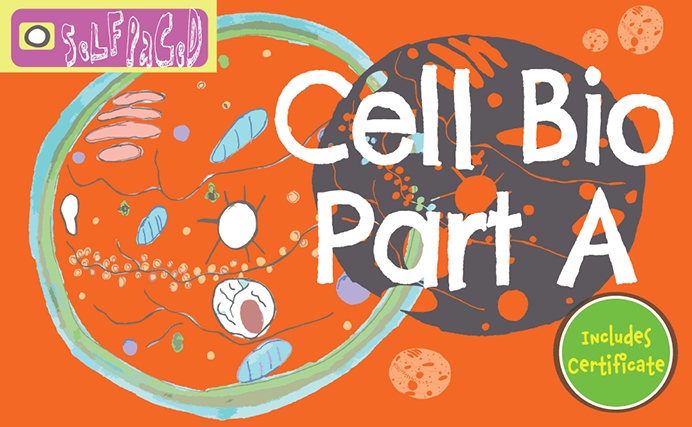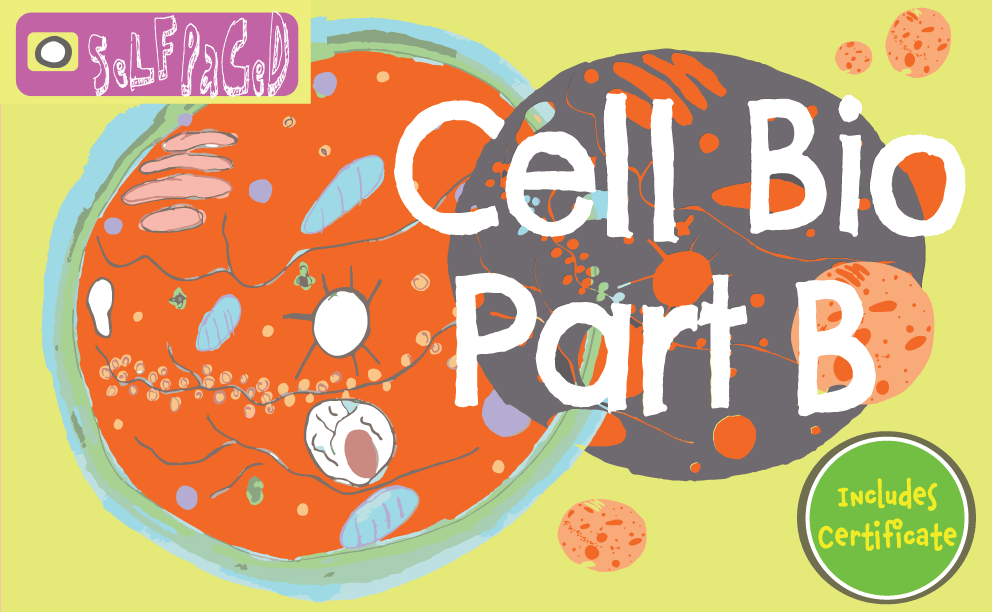9th Grade Biology Topics and Syllabus
The 9th grade biology curriculum, topics and syllabus cover high school cell biology lessons for beginners.
Parts A and B complete a typical year of high school biology.


Get unlimited access to all of our high school science courses for a low monthly membership fee.
9th Grade Biology Syllabus
Our 9th grade biology syllabus covers the topics related to cell biology. It includes lessons about various types of cells, the smallest unit of life. We focus on the structure and function of organelles, which are the tiny parts that constitute living cells. The 9th grade biology syllabus also includes a laboratory component, as biology is considered to be a lab science. The lab component focuses on learning about microscopes, making microscope drawings, analyzing simulated experiments, and keeping a lab notebook. There’s no need to purchase any additional materials, as everything is included with the online course.
The cell biology course counts as one year of high school science credit. The cell biology course is split into 2 half year parts, Part A and Part B. The course includes worksheets, evaluations, exams, cell biology labs, cell biology lab experiments, a cell biology lab manual, a 9th grade biology “video textbook” in a digestible online format, grades, a certificate, and credit for high school biology.
9th Grade Biology Topics, Part A
Part A of our ninth grade biology topics covers the structure and function of cells. We learn to draw different types of cells, and we learn about what their parts do. The focus is on understanding human cells and what keeps the human body functioning in a state of health.
Lesson 1: Drawing Prokaryotic Cells
Lesson 2: Drawing Eukaryotic Cells
Lesson 3: Drawing Plant and Animal Cells
Lesson 4: Drawing Brain, Skin and Blood Cells
Lesson 5: DNA, RNA, and Proteins
Lesson 6: Membranes
Lesson 7: Membrane Transport
Lesson 8: Blood Cells and the Lungs
9th Grade Biology Topics, Part B
Part B of our ninth grade biology topics covers cell growth and division. We learn to draw different types of cell processes. The focus is on understanding how tiny, individual human cells affect the multicellular human organism.
Lesson 1: Antibodies, Antibody Tagging, Vaccines, and Blood Types
Lesson 2: DNA Base Pairs and Replication
Lesson 3: Cell Division
Lesson 4: Mitosis
Lesson 5: Meiosis
Lesson 6: Budding, Shoots and Spores
Lesson 7: Pedigree Analysis and Inheritance
Lesson 8: X Related Traits: Anemia and Color Blindness
Is Biology for 9th Graders?
Students in grade 9 will typically have biology as their science curriculum. This is common within the United States, however it is definitely more true for some states than others. For example, it’s common for 9th graders in California, Texas, Michigan, New Jersey, Georgia, Virginia, Florida and New York to be taking biology as their science class for the school year. Other schools or school districts may focus on chemistry or physical science instead. It’s pretty rare for a 9th grade science curriculum to include physics, although some 9th grade curricula focus on Earth Science instead of biology.
What's Covered in 9th Grade Biology?
Ninth grade biology classes typically cover cells, in the subject area called cell biology. It’s a bit different than the life sciences that are studied at earlier ages, in which the life cycles of organisms, not their cells, are studied.
Typically, 9th grade biology classes will also focus on proteins, the substances which cells produce to promote life. Membranes are also an important topic, as they separate what’s inside the cell from what’s outside, as well as compartmentalize the cell. We typically think of cells as a complex factory or a little city, with all these different compartments or zones where different cellular activities occur. High school biology also tends to focus on DNA and RNA, however it’s important that a 9th grade biology class focuses on cell biology and doesn’t diverge off on a molecular biology tangent. Molecular biology is a college level subject for students who already have a strong high school cell biology background.
Students who excel in and enjoy their freshman biology experience may be interested in careers in the life sciences, medicine, nursing, or dentistry. It’s pretty typical that we have pre-medical and pre-dental students taking our biology courses, as they were designed by college professors and health care professionals.
9th Grade Biology For-Credit Course
9th Grade Biology Self Paced Course for Credit
The complete Self Paced Cell Biology course includes Part A and Part B, covering a year of high school biology for credit. It covers all of the topics shown above, focusing on cell structure and function as well as cell division for a variety of organisms. The main learning outcome is to understand how human cells affect human health and traits.
We have an online, simulated cell biology laboratory to give the feel of being in a real bio lab. It’s a complete lab science class, covering all the lessons and lab activities that a typical high school biology course includes.
Learners complete the lessons without any fixed schedule.

About Our Instructor
Hi, I’m Dr. Scott, the course instructor and author of the digital textbook that is included with the course.
I’m a former college chemistry professor who understands how to make learning science fun and easy. I empower young learners to master the fundamentals while respectfully promoting their individuality. We’ll include some games in the online course.
Our courses permit learners to discover and share science learning, to better understand themselves as well as the textbook materials.

